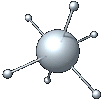
projects reviewed:
Last year's exhibitions of net art--in conjunction with such events as documenta x, ISEA and ars electronica or on the Web only--presented a plethora of projects that varied in their approach and sensibility. Nevertheless, it was possible to identify certain narrative strands interweaving the different works. One of the most prominent net narratives might be titled (psycho)geography--the attempt to find visual models for the non-locality of cyberspace, to establish connections between the geographical structures of the online and offline worlds, or to grasp the heterogeneity of identity in the digital realm. The variety of art works attempting to chart cyber-territory appears to prove that the digital world has produced a state of geographic alertness and uncertainty.
other lands
Among the projects that set out to establish a connection between the virtual and offline world was A Description of the Equator and Some Other Lands
(http://king.dom.de/equator)
--an experimental, word-based, film-related project presented in a travel-as-art loop.
The project was created by Philip Pocock and Felix Stephan Huber (whose previous works Arctic Circle and Tropic of Cancer also combined offline with virtual travel) in collaboration with Florian Wenz and Udo Noll. Like its two predecessors, "OtherLands" is both a journey into virtual reality--a symbolic exchange between authors and users over the network--and in physical space (this time to Entebbe in East Africa and other geographic destinations). The project comprises a series of digital hypermovies that are updated on a daily basis and was partially scripted and completely edited by thousands of visitors to the website and to the exhibition space at documenta in Kassel. The (traveling) authors uploaded scenes from their lives, private or fictional. Visitors navigating the site left their traces by adding, inserting or commenting on a script; words were filtered through database queries installed on the computer, vaulting the users into the screenplay and into their new roles as a global, collaborative group of auteurs. In "OtherLands," the doubling of the travel motif becomes a stylistic device in the attempt to create a world of "legible bodies" online.
|
Shifting emphasis further to the realm of physical travel, Location Sculpture SystemSystem by Eva Wohlgemuth (who also made Siberian Deal in collaboration with Kathy Rae Huffman) and Andreas Baumann establishes an imaginary and emotional network that is virtual by nature--both in the "real" and the online world. The systems consist of location sculptures placed in a natural space that has been selected on the basis of historical and cultural considerations. The different positions were marked by attaching an aluminium plate unto them which carries information on the respective system. The result is a network of geographic points--e.g. a house, wood, lake and tunnel in Switzerland or houses "framing" St.Stephan's cathedral in Vienna-- linked by information flow, association of ideas, transformation of materials. Each point in the network is a source of information in its own right but remains related to all other points. The conceptual approach reestablishes virtuality in the "real" world--even if the transparency of movement provided by hyperlinks is noticeably absent.
| |
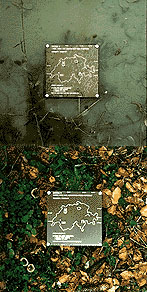
|

Location Sculpture System www.to.or.at/~siberian/theopge.htm
Yet another documenta project that established a connection between virtual and physical space was Makrolab (http://www.ljudmila.org/makrolab)constructed by Bostjan Hvala, Jurij Krpan, and Marko Peljhan. The primary conceptual and material plan for the project was provided by the Makrolab research station which the artists/scientists built on the Lutterberg hill in Kassel. The research station was designed as an autonomous, modular communications and living environment powered by sustainable energy. The object shown at the documenta exhibition space was the makrolab-console, which represented an extenal view on the actual research station on the Lutterberg hill. The project's goal was to create an interface for the discovery and recording of the events taking place in the electromagnetic spectrum--a part of the global socio-political space that is invisible and immaterial and at the same time a productive factor of general living and social conditions.
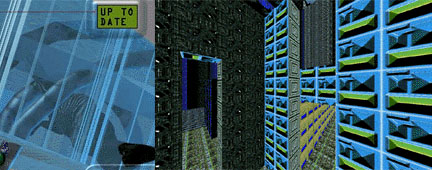
[Re]eidetification http://www.dds.nl/~basicray/reeid.html
On the other end of the spectrum are the projects that leave the physical world behind and develop online spaces designed for multi-user interaction. As Vladimir Muzhesky's [Re]eidetification points out, the on-going digital space deployment raises the question of the status of new media content: "Is the internet just a repository of infinite perceptual recombinations bound to be just another extension of the advertisement market, or is it a selfsufficient content-generating zone?" The project uses customized shared world interface and virtual reality files of prebuilt synthetic conceptual terrains as a basis for dialogues. Users can engage in conversations with the help of the Nettropics virtual world network and Basicray Spatialities Virtual Tools. The overall feel of the environment is techno-synthetic, and the philosophy of "[Re]eidetification" may be an easy solution to the content question: the basic premise is that "a user's ability to reconstruct an imaginary space on the basis of misleading perceptual markers and overloading patterns equals an ability to produce a philosophical statement in a discursive environment." If the reconstruction of virtual architecture makes for mediasophical content remains debatable. (To check it out, you may order a CD-ROM from Basicray Spatialities with a network of virtual reality home spaces at the site.)
Another multi-user Internet project allowing real-time chat between users in a virtual world is Conversations with Angels
(http://ampcom.kaapeli.fi)
by AMPCOM (Andy Best and Merja Puustinen). "Conversations" uses VRML 2.0 together with Sony's Community Place plugin for Netscape, and visitors can pick or change their avatar to interact with other people. What distinguishes the project from other "chat worlds" is the fact that users encounter robot characters that inhabit the 3D spaces permanently. The robot personalities who are based on real people and experiences are not your average angels and have the potential to put an interesting twist on the conversations. Among the characters are a serial killer, a redneck survivalist, a single mother and a lesbian princess--angels of the "real" virtual world.
The prize for the ultimate minimalist approach to cybergeography goes to Holger Friese's unendlich, fast..., ("infinite, almost...
http://www.thing.at/thing/shows/ende.html") -- an effective take on the limitations and limitlessness of the browser window. Visitors to the site encounter nothing but a blue background in their browser and can endlessly scroll down the blue color field. Infinity captured in a window--an aesthetic dream come true.
citiscapes

Shift City http://www.ilinxmedia.com/shiftcity/
The use of the offline city as a structural model for online spaces hasn't proven to be the most successful approach--what appeared to be a method for easy orientation turned out to limit the possibilities of the online world. However, the Web appears to provide an interetsing playground for experimenting with the structures of life on the other side of the screen and for capturing their essence. Two projects that both focus on the city and take a step in this direction are "Shift City" and "Pedestrian." As Rem Koolhaas once put it, "The City is an addictive machine from which there is no escape," and both projects play with the signifiers of addiction and the openness of online space.
As the introduction to Seth Ellis' and Beth McLendon's Shift City explains, the shape of a city at a single moment is a freeze-frame, a snapshot of that city's ongoing transformation. Any building or architectural element becomes a single object drifting in a sea of images, interwoven with words and meanings that become indistinguishable from the images themselves. The image becomes overloaded meaning, containing the ruins of every previous moment, archaic usages, and forgotten expressions.Shift City strives to make a new context and place--a city of transformation--arise from the fragments of information. Allowing users to explore a collage of elements from a city such as hydrants, traffic and its sound, or rumors, "Shift City" raises awareness of the symbol and its floating signification.
 Pedestrian: walking as meditation and the lure of everyday objects http://www.turbulence.org/Works/pedestrian/intro.html
Pedestrian: walking as meditation and the lure of everyday objects http://www.turbulence.org/Works/pedestrian/intro.html
Annette Weintraub's Pedestrian: walking as meditation and the lure of everyday objects takes a similar approach to the subject.The project evokes the resonance of urban space through chance encounters with ordinary objects that have the capacity to trigger altered states of memory and reverie."Walking" through episodic sections, such as "Reverie of Objects," "Neon Nocturne," or "Shoe Mortality," visitors encounter signifiers of the city as well as floating words and sentences that open spaces for meditation on the urban environment."Pedestrian" is a navigable collage, a thick soup of signs, names, and brands that uses elements of the city's addictive machinery to create an almost contemplative space that makes the city feel magical rather than oppressive.
me, myself & i
The "geography" of cyberspace is inextricably interconnected with the question of how we define ourselves in the virtual space. Online identity allows a simultaneous presence in various spaces and contexts, a constant "reproduction" of the self sans body, and a growing number of web-specific projects explores the possibilities and difficulties brought about by virtual existence.
|
Starting from Virginia Woolf's novel Orlando (written in 1928), Last Entry: Bombay, 1st of July creates a "virtual profile" of identity in the networked community. The premise is intruiging; Woolf's "Orlando"--the biography of a figure who travels through time and space, centuries and cultures, switching gender and identities--now reads like a visionary metaphor of the Internet. The website takes the form of a travel log/diary/narrative montage: visitors are invited to contribute their stories, thus involving Orlando into their own (virtual) background and bringing him/her into contact with others.
|
|
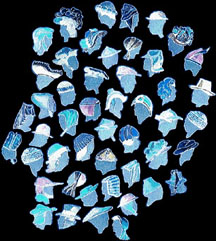
Last Entry: Bombay, 1st of July
http://www.aec.at/residence/lastentry/index.html
|
Users can also go to a page where they can download images of Orlando's latest appearance in order to change and use them in their own episode.The interface organizes episodes in the form of the profile of a head consisting of micro-profiles. The web of episodes, interweaving the realities and fictions of identity, opens up possibilities for an elaborate game with casual encounters and destiny (even if contributions don't necessarily live up to the potential of the project).
Linking territory and human behavior, Judy Malloy's Flame War (http://www.artswire.org/~jmalloy/flamewar.html)offers a completely different take on exploring our psyche. As Malloy points out, the movement west and appropriation of territory in 19th century America wasn't exactly characterized by the politeness of human behavior; in the constant struggle for existence, barroom brawls, shootouts, holdups, hangings and massacres were commonplace. No wonder "netiquette" has become such a much-discussed topic in the exploration and appropriation of Internet territory in the late 20th century.
"Flame War" makes its contribution to netiquette by providing an outlet for our anger and frustration: visitors to the site are allowed to post their verbal "flames," which will appear on the battleground of the browser window (warning: there may be flames that are so potent that they will burn up on reentry and won't be seen again). Flames are organized according to addressees, such as Uncle Sam, the Boss, or Bill Gates. If the number of flames that certain people receive is an indication of how much virtual territory they hold, the outcome of the war seems to be business as usual: a major amount of flames goes to Bill Gates.
Judging by the number of websites that focus on "survival of the fittest," Darwin seems to be experiencing a Web-revival; the trend doesn't come as a surprise considering that we live in the age of electronic reproduction. Among the sites that explore personal evolution in the digital realm is John Tonkin's The Perfectible Self (http://www.merlin.com.au/johnt), which consists of 3 java-based surveys: "Perfectible Selves," "Elective Physiognomies," and (of course) "Elastic Masculinities."The basic approach of "Perfectible Selves" is eugenics, the concept that the human race can be improved through selective breeding. Visitors to the site may evolve the artist's face by clicking on a succession of faces. Each selected one becomes the parent for a new generation of facial variations so that different traits can be exaggerated or diminished according to the user's choices. Imagine the benefits to your business or romantic life if you could judge a person's character just by looks: "Elective Physiognomies" presents various physiognomical permutations of the artist's digitally manipulated face and asks users to classify the results, which can be compared with the statistically average response. The last survey addresses "Elastic Masculinities;" women have long been struggling with the results of the cultural obsession with "looks" and self-observation--a distorted image of their bodies. Men discovered the problem not too long ago. As The Muscle Tussle New Weekly 1996 puts it: "Is the new pressure on men's appearance a balancing out of an old inequality between men and women or is it a similarly evil influence that must be stopped?" You figure it out.
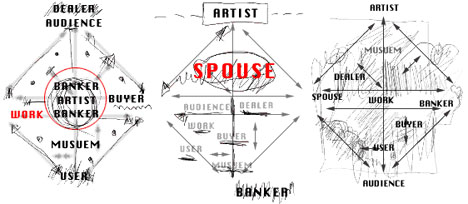
An artists kit for survival. http://www.melig.co.il/questions/
An artists kit for survival, compiled by Shoshana Cohen, focuses on the constituents determining the survival of the artistically fittest. The kit provides a framework of data relevant to the current situation and survival of the artist. The organizational structure covers basic elements of story-telling--who, what, how, where/when and why--and leads into a network of visual/textual elements and diagrams that offer models for describing the complex interelationship between content, context, media, interaction etc. The decisively analytical approach may not provide for a kit of practical tools but it visualizes the network of complexity any artistic enterprise is embedded in.
Taking a more literal approach to the geography of the artist's ego, Reynald Drouhin's Alter Ego focuses on bodyscapes. A series of body scans, quicktime movies, gif animations and "scenery projections" explores allegories of narrowness and space between all me/others/me and the other.
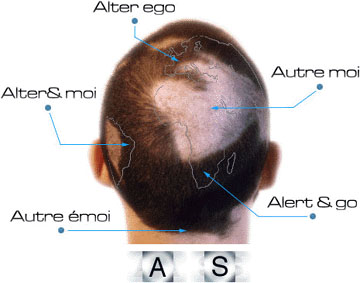
Alter ego 1/1/97 http://panoramix.univ-paris1.fr/UFR04/rhizome/ateliers/reynet/files/reynald.htm
Combining montage and innermost feelings with reproduction, The Persistant Data Confidante (by Paul Vanouse, Lisa Hutton & Eric Nyberg) fuses several elements of the above mentioned sites. It could be described as an exercise in democratic confidentiality. "The Persistant Data Confidante" (http://www-crca.ucsd.edu/~pdc) provides an anonymous forum for those who long to indulge in confessions and secrets with people they've never met. The project is strictly user-curated: anybody can post a secret, and the approval ratings of visitors decide how long a confession survives. Secrets that don't find the community's approval are democratically eradicated by low ratings. The retelling of secrets by nature leads to distortion, and "The Persistant Data Confidante" democratizes the process: as secrets are retold and age, they become capable of producing offspring. Secrets that have experienced many re-tellings and belong to the top 10% in popularity, will mate with a secret of similar content--producing an offspring composed of major clauses from the two parents. Newborn secrets then try to survive the harsh environment of the database by gaining user approval.
|
Last but not least, Hervé Graumann's l.o.s.t. sums up the feelings many of us experience while exploring cyber-geography. Visitors to the site encounter a black space and their cursors take the form of a white circle. Moving around the circle, one realizes that it is a kind of flashlight which allows to explore the dark space.
|
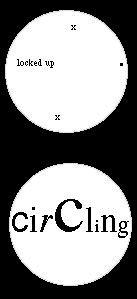 l.o.s.t. l.o.s.t.
http://www.ave.ch/echo/lost.html
|
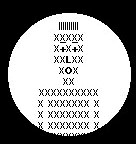
|
With the help of the light, one discovers what could be the scribblings on the wall left by somebody forever lost in cyberspace, endlessly circling--a tiny data body that has become indistinguishable from the writing on the wall.
|
|
© Hyperactive Co. 1998






 Pedestrian: walking as meditation and the lure of everyday objects http://www.turbulence.org/Works/pedestrian/intro.html
Pedestrian: walking as meditation and the lure of everyday objects http://www.turbulence.org/Works/pedestrian/intro.html




